IHaveHugeNick
Arcane
- Joined
- Apr 5, 2015
- Messages
- 1,870,182
This is what happens when you do verbatim transcription of calinglesse.
...but Icewind Dale asked the player, with no tutorial, to create six Advanced Dungeons & Dragons Second Edition characters. Just go do it, then play the game! Nowadays we look back at that like… what the hell were we thinking?!
Jesus, you've got to read the manual for FIVE minutes to roll a fucking party! FIVE MINUTES, WHAT WERE THEY THINKING?!
And what does he mean under "tutorial for party creation"? When you first start a game, developers call you on skype and DM some D&D sessions for you?
Feargus is a total goober, but in most of his interviews he has something interesting to reveal.
This is not one of those interviews.















Beyond Infinity: Obsidian on modernising the art of the isometric RPG
Rick Lane on September 4th, 2017 at 9:00 pm.

When Obsidian Entertainment started work on Pillars of Eternity [Official Site], the studio had two goals in mind. First, it wanted to recreate the style and tone of the classic Black Isle RPGs – particularly Baldur’s Gate. Second, it wanted to modernise that style, taking advantage of today’s technology, and avoiding mistakes made the first time around.
In both cases, the visual representation of Pillars’ fantasy world was crucial to the success of the project. Baldur’s Gate’s distinctive pre-rendered backgrounds have become synonymous with isometric RPGs, and as a spiritual successor to Baldur’s Gate, Pillars needed to evoke that look. But Obsidian also wanted to bring those static backdrops to life using modern graphical techniques: dynamic lighting, particle effects, 3D character models. It would be a blend of old and new, fusing the visual style of Black Isle with modern techniques.
To help promote the Kickstarter campaign, Obsidian released a concept image of what they intended the final game to look like. It’s a gorgeous picture, depicting an idyllic pastoral landscape with verdant foliage, a lichen-covered bridge, ancient marble statues and a crystalline waterfall. It sold the fantasy brilliantly, helping to raise almost four times the funding Obsidian originally asked for.
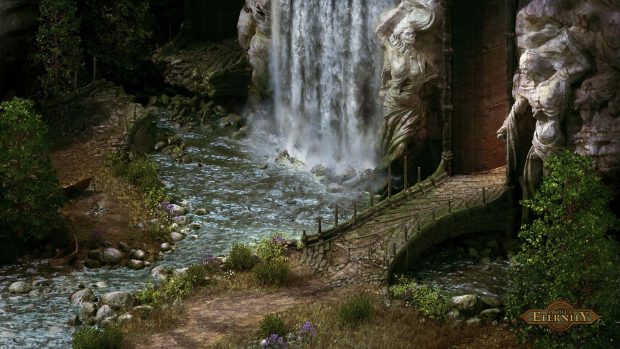
There was just one small problem. Obsidian didn’t know how to make the game look like that.
“We had no idea how the tech would even work at the time,” says Adam Brennecke, executive producer on Pillars of Eternity. “The next eight months of development was trying to figure out how to actually make a game that still looked like the Infinity Engine.”
Recreating the aesthetic of a fifteen-year-old, two dimensional RPG sounds like it should be easy, especially with the technology available to today’s developers. But Baldur’s Gate was built on a unique and highly idiosyncratic engine, using a rendering technique that has been somewhat lost to the ages. The problem revolved around Baldur’s Gate’s use of pre-rendered backdrops. Pre-rendering was a clever way of creating detailed, high-resolution environments at a low cost to performance, as the static image means the computer doesn’t have to redraw it with each new frame.
Today, there’s no need for pre-rendering because games can render stunning 3D environments in real-time. Nevertheless, this was the approach Baldur’s Gate used and Obsidian needed to mimic that to live up to their promise. But to look good on a modern PC screen, a pre-rendered image needs to be many times sharper and more detailed than back in 1999.
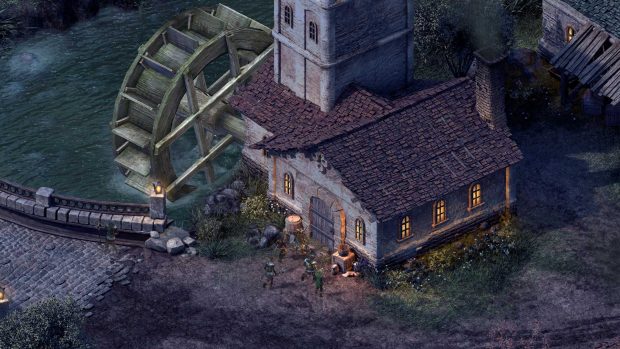
In theory, this isn’t a problem. In fact with today’s computers you can potentially render an image with an infinite number of polygons, something that Obsidian had a lot of fun experimenting with. “Our backgrounds, they have millions and millions of really high poly, highly dense geometry, and the art-team just go wild with it.”
The problem is that rendering these images at such detail takes a lot of time. “It takes days to render these images out, because they’re so high-res, they’re 10,000 by 10,000 pixels,” says Brennecke. “It’s more like how a movie is made, where you need a fat renderer farm with a lot of computers churning out these really highly dense, really crazy images all night and all day….that was a big learning process for us, how to hit that balance and figure out how to render things offline.”
Alongside the brute-force of rendering these images, Obsidian needed to adapt the Baldur’s Gate style to suit these sharper images. For inspiration, the art team looked to the Hudson River School, a 19th Century American art movement which produced pastoral landscapes heavily influenced by romanticism. Meanwhile, one of Obsidian’s engineers, Michael Edwards, created a pixel shader that accurately mimicked the Infinity Engine’s approach to rendering. “It was a very accurate representation of how the Infinity engine kind of did their rendering pipeline,” Brennecke says.

With the basics in place, Obsidian created their first dungeon, only to find it looked nothing like Baldur’s Gate. So they went back to Baldur’s Gate and re-examined that game’s aesthetic from every possible angle. “There were a lot of little tricks that they learned how to present the image. For example, especially for interior areas, the front-facing walls are all not there. You don’t draw those at all.” Brennecke says. “The tops of the walls are all black. So it makes, like, where this image is sitting in a black void. Our first prototype dungeons didn’t look anything like that.”
Obsidian’s art team also struggled adjusting to drawing isometric backdrops in general, not only making environments look nice, but also appear proportionally correct from that perspective. “For any height difference, you need a ramp to connect those heights, and whenever you have a ramp that is sloping away from you, it ceases to read as a ramp in our mind because there is no perspective, there is no sense of depth,” says Kaz Aruga, concept artist on Pillars of Eternity and lead artist for Pillars 2. “As you go up the image, you want to make sure it’s increasing in height, not decreasing.”
Eventually, the art-team focussed on developing one area, a tavern interior, with a mind to replicating the Infinity style as accurately as possible. “When we got it into the game, we were like ‘Hey that looks good, we hit the mark with that.’ Then we designed our dungeons with all that in mind,” Brennecke says.
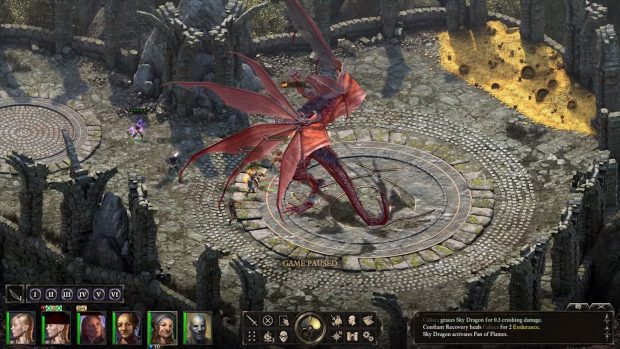
Like many developers, Obsidian’s design team had spent years working with real-time 3D graphics. Hence, trying to create 2D, pre-rendered, isometric visuals was like forcing a modern textile manufacturer to work with a spinning jenny. When Obsidian began the process of introducing more modern elements like 3D models to Pillars of Eternity, the process became considerably easier.
“The decision to go 3D with the characters was pretty much a no-brainer for us,” says Aruga. “If you go pure 2D you’re making everything, and everything is raw data at that point. So you’re losing a lot of flexibility, like a hat that got rendered out for a set of sprites may not work for a slightly larger character and that’s a unique asset you have to create. Whereas 3D, you just make the abstract hat asset once, and it pops onto the various different rigs.”
The same goes for lighting and shading. Back in the early isometric days with games like Fallout, all of the lighting and shading information had to be detailed manually, a painstaking process undertaken at the time by a designer named of Scott Everts. “He had to paint into the tint information for every single map, for every location,” Aruga says. “So imagine like a fiery, reddish-lit temple interior or something. He would have to go in and define how the character sprites would be tinted.” In Pillars of Eternity, all that information is calculated by the lighting engine, so all the artists have to do is place the lights and define colour, intensity and other variables to create the desired effect.

Replicating the look and vibe of Baldur’s Gate applied not only to the general aesthetic of Pillars of Eternity but also to the fantasy world Obsidian was building. Given that the game was crowdfunded, Obsidian was aware that backers would have certain expectations of what the experience would be like. Consequently, Obsidian focussed on making the fantasy world grounded and believable over unique and unusual.
At the same time, however, they didn’t want to fall too deeply into cliché. “We base everything in sixteenth-century, central medieval Europe, or medieval time-period, in between medieval and renaissance,” says Brennecke. “And when we introduce fantasy elements, we try to introduce them where it’s like, you kind of know what it is right off the bat, but there’s a unique twist to it, or something that’s unusual about it.”
The key thing with Pillars, however, was to get the game out the door. To get the art-style right, to get the tech working, to meet the expectations of the Kickstarer backers. Yet while Obsidian worked on Pillars, it was also developing another isometric RPG, one with goals at the opposite end of the fantasy spectrum.
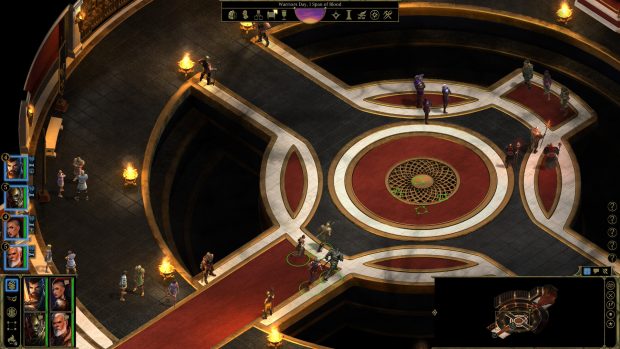
Where Pillars of Eternity was designed to meet the expectations of Black Isle fans, in many ways Tyranny was designed to subvert them. It’s an RPG where the evil overlord has won, where your character gets to decide not how to save the world, but how to subjugate it to their will. Even the game’s development cycle was markedly different from Pillars. Where with Pillars a lot of the time was spent getting the tech to work, Tyranny didn’t have to worry about any of that. Indeed, there was a period towards the end of Pillars’ development where the Tyranny team consisted solely of artists, because as game director Brian Heins jokes, “at one point they stole all of our programmers for several months.”
With Tyranny, Henis deliberately wanted to move away from the traditional style that Pillars embraced. This was partly because of the darker, more modern themes that Tyranny was exploring, but also so that people didn’t confuse Tyranny as a sequel or spiritual successor to Pillars. “We wanted to make sure that the game didn’t feel like it was, uh, Pillars 1.5, or was trying to step on the toes of the Pillars franchise,” Henis says. “It was like ‘Well if you have screenshots side-by-side of the two games, and they don’t look like each other. People aren’t going to expect that they are sequels of each others, or set in the same world.”
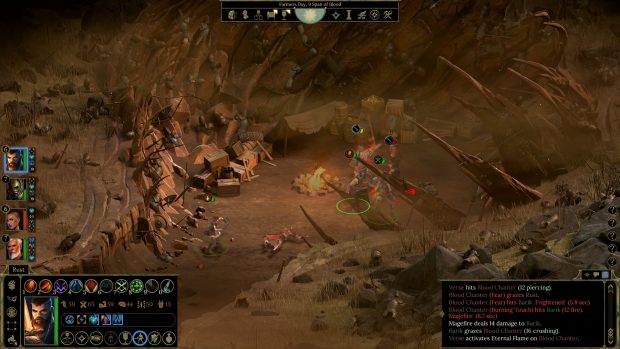
For Tyranny’s art, the designers deliberately moved away from the grounded fantasy of Pillars, shifting toward something more surreal and stylised. “We tend to have much more simplified forms,” Henis explains. “Like with the characters, if you open the paper doll, you can see they have much more sharply defined lines than a realistic approach would. And we had the same approach to the environment. Even our textures, we went much more low-detail on the texture. Probably [an] even more painted look to the textures than even Pillars 1 did.”
Alongside helping to distinguish Tyranny from Pillars at-a-glance, this more stylised form also acted as a buffer between the player and the subject-matter. Depicting Tyranny’s downtrodden and decaying realm was a difficult balancing act for the team, as they didn’t want to make it so grim and depressing that nobody wanted to play. “We had to kind of find this balance of straddling the line between something that looked beautiful, but not so beautiful that it felt like it was a happy fantasy-land,” Heins says.
The more abstract, surreal style was one approach to doing this, but the designers coupled this with small yet frequent reminders of the long and bloody war for which the player is tasked with swinging the final blow. “Every armour piece that you find has dents and nicks and corrosion, nothing’s brand new and shiny. Everything has been through the war. Every detail you look at, canvas tarps are mended and patched. Nothing is pristine,” Henis says.

Within a year Obsidian had released two very different isometric RPGs, one a classic, grounded fantasy, the other dark, twisted and unconventional. Now they’re working on a third – Pillars of Eternity 2: Deadfire. For the sequel, Obsidian has taken cues from both previous projects, retaining that link to the classic Infinity RPGs, but setting their story in a new, and far more exotic location. “Deadfire is a place where it is very different from the Deerwood,” Brennecke says. “The cultures that you’ll find there, the look of the buildings, the architecture, the cities are all completely new and different.”
To complement this, Obsidian is working on a much more complex blend of pre-rendered and real-time elements. This includes reflection probes – so the pre-rendered backgrounds will be reflected in metallic objects such as 3D armour worn by your party. In addition, characters will be lit by indirect lighting from the pre-rendered scene. “So for example, if you have a red light, and it bounces down the hallway, our characters are actually lit properly with that bounce-light,” Brennecke adds.
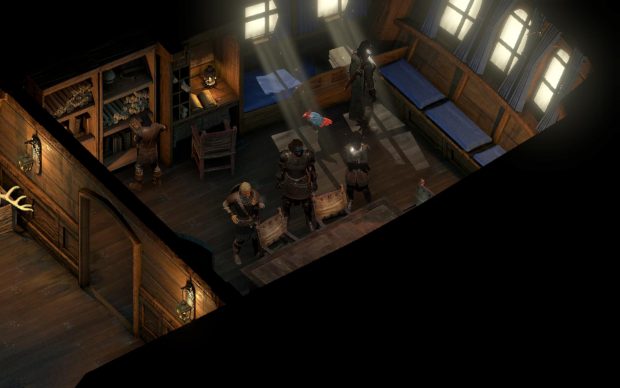
Perhaps most intriguingly of all, in response to criticisms that the’ environments were too static, Obsidian has reworked the tech so that these pre-rendered background will, somehow, cast real-time shadows. “The pre-rendered elements in the background scene will actually cast a shadow, so you can calculate cast-shadows from a cliff-side that is pre-rendered, casting a shadow onto the 3D characters who are overlaid in front. Kind of twists your mind a little bit,” Aruga says.
Obsidian is so pleased with the way the lighting and the backgrounds react with one-another that they’ve partially built a party character around the effect to show it off. “One of the characters that you get fairly early-on is a character named Shodi, and Shodi has a lantern that she holds. There’s a narrative reason why she has a lantern. But it’s really cool because you get her early on and you can adventure with her.” Aruga says. “Walking down very dimly lit dungeons, you can see how all the materials react with one another, how the light bounces off walls and stuff like that. It looks amazing.”
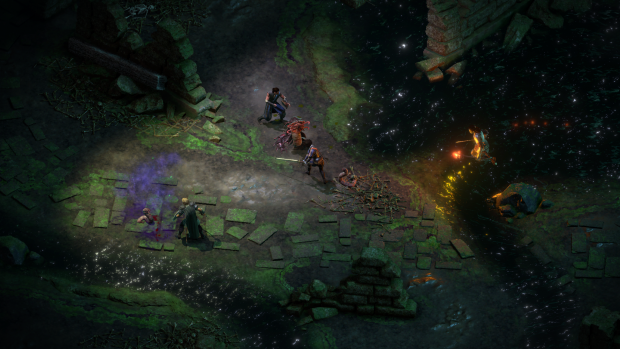
With Pillars of Eternity, Obsidian knew what kind of game they wanted to make, but didn’t know how to make it. With the sequel, both these potential problems have already been solved, and Obsidian can simply focus on making the game they want to make. “We did the heavy lifting in the base game,” Aruga concludes. “If the base game was like a rollercoaster, where we’re fixing the coaster as it was going up the hill, it feels like Pillars 2, the production feels like riding a Lamborghini or something. It’s so much smoother.”
















Did he left because Avellone and Parker decided that his vision is shit,
lol "Deerwood"
But that's not what it means. It's a love letter from a man to a tree. Should be "Dear Wood, I miss you...bla bla bla"lol "Deerwood"
Well there were deer in there.
But that's not what it means. It's a love letter from a man to a tree. Should be "Dear Wood, I miss you...bla bla bla"lol "Deerwood"
Well there were deer in there.
But that's not what it means. It's a love letter from a man to a tree. Should be "Dear Wood, I miss you...bla bla bla"lol "Deerwood"
Well there were deer in there.
I don't think I want to know any more about Josh's fetishes.
NV was a hit as big as Mass Effect, and they almost gone bankrupt a few years later.With more polish and better gameplay that game would have be as big of a hit as Mass Effect and Obisidan would've gone full Bioware. AP floping may have hurt the company but at least they have to try to stay true to their roots, because it's the only thing keeping them alive.
well, at least from what i seen on normie forums like reddit and gamefaqs, the perception has been slowly changing. The mid core gamers startin to think that nv is superior to 3 and 4. It is just bethesda fan or ultra bottom barrel casual that think otherwise.NV was a hit as big as Mass Effect, and they almost gone bankrupt a few years later.With more polish and better gameplay that game would have be as big of a hit as Mass Effect and Obisidan would've gone full Bioware. AP floping may have hurt the company but at least they have to try to stay true to their roots, because it's the only thing keeping them alive.
That's because when Bethesda makes a game in 5+ years on their own engine, with a huge amount of bugs, people think it's okay, it's 8/8, because Bethesda is a synonym for quality, everyone knows that.
But when Obsidian makes a game (superior to everything Bethesda did in a long time), in 3- years on engine, that is new to them, with the same amount of bugs, people say that Obsidian suck balls, and can't do shit.
But when Obsidian makes a game (superior to everything Bethesda did in a long time), in 3- years on engine, that is new to them, with the same amount of bugs, people say that Obsidian suck balls, and can't do shit.

NV was a hit as big as Mass Effect, and they almost gone bankrupt a few years later.
It's interesting because most people would rather see another Fallout game on the West Coast, instead than AP2.At the very least, its success would have resulted in a sequel. There was nowhere to go but elsewhere after New Vegas.
Tim and Leonard can now strike into that New Vegas vein with what ever it is they're cooking and leech that audience. It's been sounding like they're trying to.







